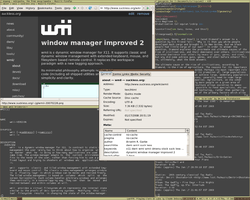wmii
 | |
|
wmii with both 'tiled' and 'stacked' windows. | |
| Original author(s) | Anselm R. Garbe |
|---|---|
| Developer(s) | Kris Maglione |
| Initial release | June 1, 2005[1] |
| Stable release |
3.9.2
/ June 10, 2010 |
| Written in | C |
| Operating system | Unix-like |
| Size | 422 KB[2] |
| Type | Window manager |
| License | MIT License |
| Website |
code |
wmii (window manager improved²) is a tiling window manager for X11. It supports stacking and tiling[3] window management with extended keyboard, mouse, and filesystem based remote control. It replaces the workspace paradigm with a new tagging approach.
In its default configuration, wmii's interface is similar to that of the vi text editor; the windows are controlled with the Alt key and the HJKL keys (Alt+H,J,K,L) and can be combined with Alt+Shift+H,J,K,L. This enables one to build dynamic layouts easily in contrast to other window managers with fixed layouts such as Ion. However, the window manager offers extensive configuration through a virtual filesystem similar to that offered by Plan 9 from Bell Labs.[3] Every window, tag, and column is represented in the virtual filesystem, and windows are controlled by manipulating their file objects (in fact, the configuration file is just a script interfacing the virtual files). This RPC system allows many different configuration styles, including those provided in the base distribution in plan9port and bourne shell. The latest release 3.9 also includes configurations in Python and Ruby.[4]
In its latest release, wmii supports Xinerama and ships its own keyboard-based menu program called wimenu, featuring history and programmable completion.[4]
Similar window managers
- dwm
- awesome
- Ion
- ratpoison
- stumpwm, the successor to ratpoison
- rio, Plan 9 from Bell Labs' windowing system
- Xmonad, a tiling window manager written in Haskell
- i3 (window manager), a similar tiling window manager written in C
See also
- 9P, the filesystem protocol used to implement wmii's virtual filesystem
- Plan 9 from User Space (aka plan9port)
Further reading
- Nico Golde, (March 2006) No wimps. A look at the Wmii Window Mmanager, Linux Magazine, issue 64
- Philipp Klein, (May 2005) Light and speedy. WMI and the reincarnation of the keyboard, Linux Magazine, issue 54 (covers its predecessor)
- Mike Saunders (March 2008) Lightweight window managers, Linux Format, issue 103 (round-up of several similar window managers, including wmii 3.6)
References
- ↑ Initial release date
- ↑ http://dl.suckless.org/wmii/wmii+ixp-3.9.2.tbz
- 1 2 wmii - Window Manager Improved, Improved - Google Project Hosting. Wmii.suckless.org. Retrieved on 2013-07-13.
- 1 2 suckless.org git repositories. Hg.suckless.org. Retrieved on 2013-07-13.
External links
| Wikimedia Commons has media related to wmii. |
